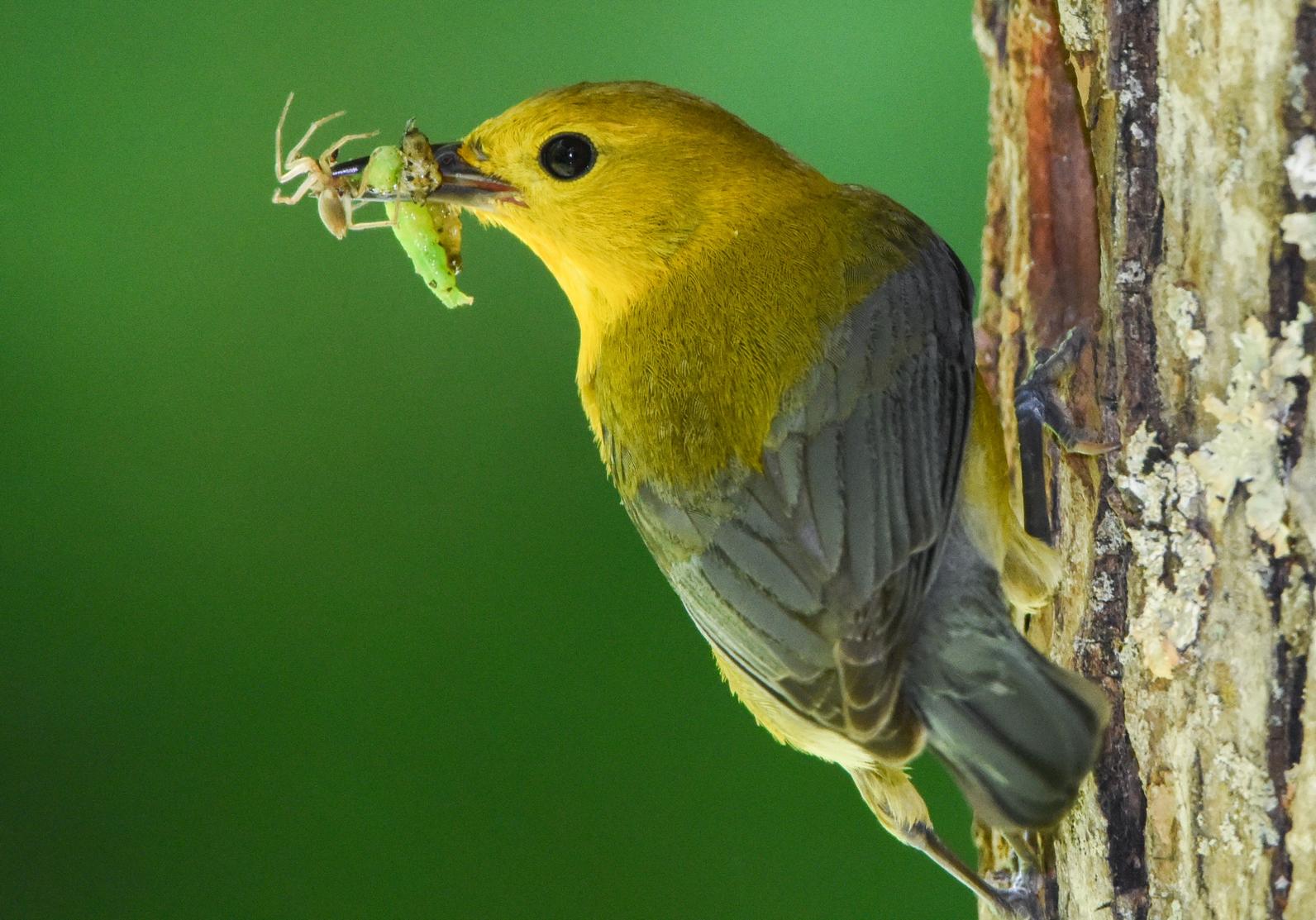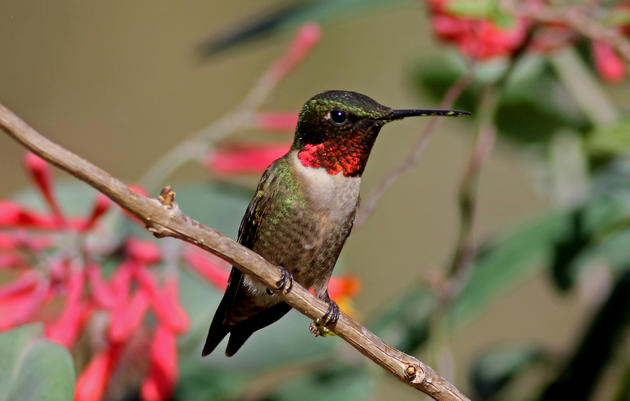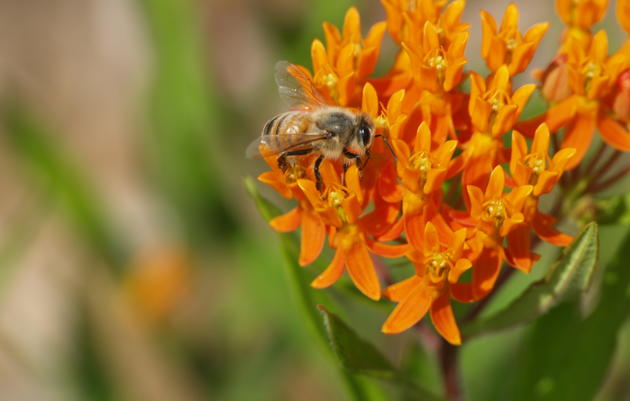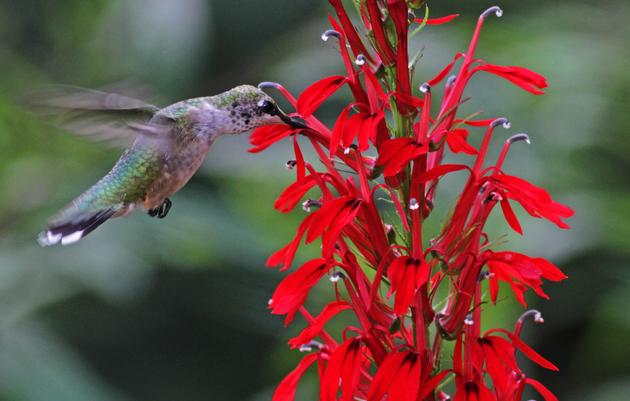In an effort to help you put native plants in the ground, we asked our experts—Joy and Andy—to answer your top questions about:
"GETTING STARTED! How to create bird-friendly habitat where you live."
First thing's first, what are native plants?
Native plants are plants that coevolved with the animal life of a geographic area over thousands or millions of years. For example, while a Blue Spruce may be native to North America, it is not native to the Northeast and the wildlife here has not evolved with and adapted to it. It will have low ecological value in this area.
Different adaptations make the overall species stronger and more resilient to changes in the environment. When possible, you should try to get native plants that are adapted to your area's conditions. These will be plants that best benefit local insects, local birds, and even you--by requiring less maintenance.
Find the best plants for your area here: https://ny.audubon.org/get-outside/plants-for-birds
Click here to watch a webinar presentation on native plants and pollinators.
Your Questions, Answered.
Q: Should I stop filling my bird feeders in spring when plants and flowers start blooming?
A: You may want to supplement birds with seed and suet until your yard, or local community, has enough plants to support them. After this point, you’re really just feeding them for your own entertainment! Any warm weather feeding should also include a regular cleaning regime so as not to allow birds to spread diseases to each other.
If you stop offering food in late March, the birds may help clean up your “weed seeds.” They will also feed on seed-heads and find insects hidden in the stems of native perennials in winter through to early spring (don’t trim until late spring for this reason!). Any overwintering larvae and pupae the birds don’t find will become your seasonal native pollinators.
The most important thing at this time of year is that the birds have caterpillars and other insects to feed their chicks, and that requires having lots of native plants which the insects need to survive. You can put them on your balcony, in your backyard, or in gardens across your community.

Q: I have terrible soil, but I want to help put native plants in the ground! Is there something easy I can grow while I work on improving my soil?
A: Hold on a second! Before you try to “improve” anything, take note - if you’re planting tropical and annual bedding plants, which love rich organic soil, “terrible soil” can be a frustrating issue. But usually, the soil in our yards is the same type of soil that is found throughout our local ecoregions. That soil is actually perfect for your local native plants because those plants evolved to thrive in that same soil! The key is to pick the right plant for the right place.
If you plant something like Butterflyweed (Asclepias tuberosa) or Little Bluestem (Schizachyrium scoparium) in rich, amended garden soil, they will either flop over or not flower well. Instead, plant Butterflyweed in a well-drained sunny hillside.
For those who want to go the extra mile, get your soil tested for pH and nutrients. After sun and soil moisture, pH is the next most important item then nutrients. Google “soil test” and your “state”. Your land grant universities and agriculture extension offices will come up in the search and they will have directions on how to get your soil tested. It is not very expensive and may save you a lot of time and trouble.
Q: What can I plant to attract bees and other pollinators?
A: Did you know that there are approximately 3,600 bee species native to North America north of Mexico? You might want to ask yourself instead, “Which bees do I want to attract?” Then you can plan for how to attract them.
Most native bees prefer specific native plants because they co-evolved with their nectar sources. Certain bees emerge when the specific plants they use flower. The best way to provide forage for all the pollinators would be to focus on the pollinators who have specific needs, and the generalists will use those sources, too.
As a good rule of thumb, larger generalist bees usually prefer native plants with bell-shaped blooms, like Beardtongues (Penstemon hirsutus and P. digitalis), Coral Bells (Heuchera) and Foam flower (Tiarella) and smaller generalist bees prefer flat ray-type upward facing blooms like Threadleaf Tickseed (Coreopsis verticillata) or the native Sunflowers (Helianthus angustifoluis, H. divaricata and H. annuus). But they’re called generalists for good reason, so you might find a bumble bee on any large bloom.
One very important consideration -- plant flowers that bloom at different times. Bees need nectar and pollen for the whole growing season, not just June and July.
Q: What can I plant to attract and feed hummingbirds?
A: The easiest and fastest answer? Native, tubular flowers (especially red) that favor long tongues. Red tubular blooms are preferred, but tube-shaped or bell-shaped blooms in any color may be used.
Some excellent Native sun-loving plants that hummingbirds prefer are Bee Balm and Bergamot (Monarda didyma and M. fistulosa), Garden Phlox (Phlox paniculata), Beardtongue (Penstemon hirsutus and P. digitalis) and Trumpet Honeysuckle (Lonicera sempervirens). For wetter but still sunny areas, use Cardinal flowers (Lobelia cardinalis and L. siphilitica) and Swamp Verbena (V. hastata). They also like Trumpetvine and Crossvine, but those vines need strong support and can become invasive.
In shadier conditions, try Native deciduous Azaleas like Pinkster or Swamp Azaleas (Azalea/Rhododendron periclymenoides and A/R. viscosum), Coral Bells (Heuchera americana and H. villosa), Foam flower (Tiarella cordifolia), Pinkroot (Spigelia marilandica), Columbine (Aquilegia canadensis), Fern-leaf Bleeding Heart and Dutchman’s Breeches (Dicentra eximia and D. cucullaria), and Creeping and Moss Phlox (Phlox stolonifera and P. subulata).
Q: What are some container-loving plants for those who want to start gardening in a small space?
A: Container gardens offer so many options, from simple, single-plant systems to multi-leveled and extended blooming displays.
For those who like to keep things simple, stick to shorter plants that will not get topheavy or wilt at the first sign of drought - because it usually happens to containers at some point. For a combination of plants that will bloom at different times in a part to full-sun location, try Penstemon (sp.), Lanceleaf Coreopsis, Wild Geranium, Agastache anise, and Silverrod (Solidago Bicolor).
It is difficult to have a continuously blooming display using natives in containers. That being said, native annuals that grow well in containers in full sun are Black-eyed susan (Rudbeckia hirta) and Annual Sunflower (Helianthus annuus).
A good suite of plants to use in a dry sun mixed container would be Little bluestem, Black-eyed-susan, (Rudbeckia hirta), Gray Goldenrod (Solidago nemoralis), Bush Aster (Aster/ Symphyotrichum dumosus/dumosum), and Moss Phlox (Phlox subulata).
A taller mixed container for moist to wet sun could consist of Blazing Star (Liatris spicata), Switchgrass (Panicum virgatum), Winter-hardy Hibiscus (Hibiscus moscheutos) Cardinalflower, (Lobelia cardinalis) and a short cultivar of Swamp Sunflower (Helianthus angustifolius) like ‘Low Down’ or ‘First Light’.
For shadier moist conditions, try Cardinalflower with Foamflower (Tiarella cordifolia) Maidenhair Fern (Adiantum pedatum) Swamp Milkweed (Asclepias incarnata), and Moss Phlox (Phlox stolonifera).
Q: Is there such thing as a deer-resistant plant? What can I add that won't be eaten by deer?
A: Keep in mind... deer do not read our lists. Deer in different locations may develop different eating habits, so what works in one place may not work in another. Also remember that with hunger, everything becomes edible in leaner years.
Spicebush (Lindera bensoin) and Black Huckleberry (Gaylussacia baccata) are very deer-resistant. They are rarely eaten even when there is nothing else available. Most of the time these are the only two species left in forest understories with high deer populations. Use these in shady dry conditions.
Rutgers University states that Eastern Red Cedar (Juniperus virginiana) is “seldom severely damaged..."Perhaps New Jersey deer don’t like them, but New York's deer don't seem to have gotten that memo.
The best way to test deer-resistance in your area is to buy just one of each plant touted as “deer resistant.” Then cut up an apple and place a couple of pieces at the base of your plants. If the apple is gone and you see hoof-prints but no damage to your shrubs, you can be cautiously optimistic that your choices are reasonably deer resistant. If the apple disappears with no damage to the leaves, and no hoofprints, but your perennials are wilting, then you have voles – which is an entirely different issue!
About Joy and Andy
Joyann Cirigliano is a Natural Historian and Ecosystem Specialist, Certified Nursery and Landscape Professional (CNLP), and National Wildlife Federation Certified Wildlife Landscape Professional (NWF-CWLP). She is an approved Pesticide Trainer for the NYS Department of Environmental Conservation for Ornamental Horticulture, Turfgrass and Native Plants, where she teaches how not to use pesticides yet still control pest issues. When asked whether she preferred plants or animals, her response was, "My favorite form of life is canine. Except when he eats all the raspberries..."
Andy Chapin is the Land Steward at the Greenwich Audubon Center, one of three vibrant nature education centers operated by Audubon Connecticut.






